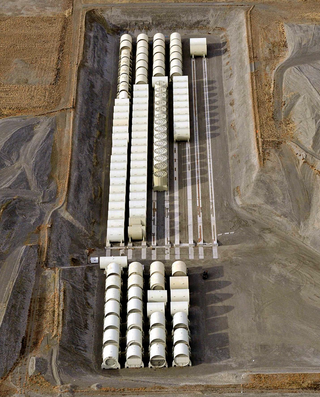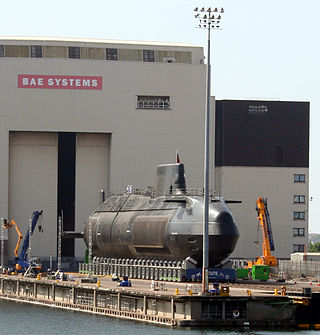
The Los Angeles class of submarines are nuclear-powered fast attack submarines (SSN) in service with the United States Navy. Also known as the 688 class after the hull number of lead vessel USS Los Angeles (SSN-688), 62 were built from 1972 to 1996, the latter 23 to an improved 688i standard. As of 2024, 24 of the Los Angeles class remain in commission—more than any other class in the world—and they account for almost half of the U.S. Navy's 50 fast attack submarines.

United States naval reactors are nuclear reactors used by the United States Navy aboard certain ships to generate the steam used to produce power for propulsion, electric power, catapulting airplanes in aircraft carriers, and a few more minor uses. Such naval nuclear reactors have a complete power plant associated with them. All commissioned U.S. Navy submarines and supercarriers built since 1975 are nuclear powered, with the last conventional carrier, USS Kitty Hawk, being decommissioned in May 2009. The U.S. Navy also had nine nuclear-powered cruisers with such reactors, but they have since been decommissioned as well.

A pressurized water reactor (PWR) is a type of light-water nuclear reactor. PWRs constitute the large majority of the world's nuclear power plants. In a PWR, the primary coolant (water) is pumped under high pressure to the reactor core where it is heated by the energy released by the fission of atoms. The heated, high pressure water then flows to a steam generator, where it transfers its thermal energy to lower pressure water of a secondary system where steam is generated. The steam then drives turbines, which spin an electric generator. In contrast to a boiling water reactor (BWR), pressure in the primary coolant loop prevents the water from boiling within the reactor. All light-water reactors use ordinary water as both coolant and neutron moderator. Most use anywhere from two to four vertically mounted steam generators; VVER reactors use horizontal steam generators.
The A2W reactor is a naval nuclear reactor used by the United States Navy to provide electricity generation and propulsion on warships. The A2W designation stands for:
The S1C reactor was a prototype naval reactor designed for the United States Navy to provide electricity generation and propulsion on warships. The S1C designation stands for:
The S3G reactor is a naval reactor used by the United States Navy to provide electricity generation and propulsion on warships. The S3G designation stands for:

The S5G reactor was a prototype naval reactor designed for the United States Navy to provide electricity generation and propulsion on submarines. The S5G designation stands for:
The S6G reactor is a naval reactor used by the United States Navy to provide electricity generation and propulsion on Los Angeles-class attack submarines. The S6G designation stands for:

A nuclear submarine is a submarine powered by a nuclear reactor, but not necessarily nuclear-armed. Nuclear submarines have considerable performance advantages over "conventional" submarines. Nuclear propulsion, being completely independent of air, frees the submarine from the need to surface frequently, as is necessary for conventional submarines. The large amount of power generated by a nuclear reactor allows nuclear submarines to operate at high speed for long periods, and the long interval between refuelings grants a range virtually unlimited, making the only limits on voyage times being imposed by such factors as the need to restock food or other consumables.

A diesel–electric transmission, or diesel–electric powertrain, is a transmission system for vehicles powered by diesel engines in road, rail, and marine transport. Diesel–electric transmission is based on petrol–electric transmission, a transmission system used for petrol engines.
The S1W reactor was the first prototype naval reactor used by the United States Navy to prove that the technology could be used for electricity generation and propulsion on submarines.

Nuclear marine propulsion is propulsion of a ship or submarine with heat provided by a nuclear reactor. The power plant heats water to produce steam for a turbine used to turn the ship's propeller through a gearbox or through an electric generator and motor. Nuclear propulsion is used primarily within naval warships such as nuclear submarines and supercarriers. A small number of experimental civil nuclear ships have been built.
The Army Nuclear Power Program (ANPP) was a program of the United States Army to develop small pressurized water and boiling water nuclear power reactors to generate electrical and space-heating energy primarily at remote, relatively inaccessible sites. The ANPP had several accomplishments, but ultimately it was considered to be "a solution in search of a problem." The U.S. Army Engineer Reactors Group managed this program and it was headquartered at Fort Belvoir, Virginia. The program began in 1954 and had effectively terminated by about 1977, with the last class of NPP operators graduating in 1977. Work continued for some time thereafter either for decommissioning of the plants or placing them into SAFSTOR. The current development of small modular reactors has led to a renewed interest in military applications.

The light-water reactor (LWR) is a type of thermal-neutron reactor that uses normal water, as opposed to heavy water, as both its coolant and neutron moderator; furthermore a solid form of fissile elements is used as fuel. Thermal-neutron reactors are the most common type of nuclear reactor, and light-water reactors are the most common type of thermal-neutron reactor.
Air-independent propulsion (AIP), or air-independent power, is any marine propulsion technology that allows a non-nuclear submarine to operate without access to atmospheric oxygen. AIP can augment or replace the diesel-electric propulsion system of non-nuclear vessels.

The S3W reactor is a naval reactor used by the United States Navy to provide electricity generation and propulsion on warships. The S3W designation stands for:

Marine propulsion is the mechanism or system used to generate thrust to move a watercraft through water. While paddles and sails are still used on some smaller boats, most modern ships are propelled by mechanical systems consisting of an electric motor or internal combustion engine driving a propeller, or less frequently, in pump-jets, an impeller. Marine engineering is the discipline concerned with the engineering design process of marine propulsion systems.

The upcoming Columbia-class nuclear-powered ballistic missile submarines of the United States Navy are designed to replace the Ohio class. Construction of the first vessel began on 1 October 2020. She is scheduled to enter service in 2031.
The United States Navy Nuclear Propulsion community consists of Naval Officers and Enlisted members who are specially trained to run and maintain the nuclear reactors that power the submarines and aircraft carriers of the United States Navy. Operating more than 80 nuclear-powered ships, the United States Navy is currently the largest naval force in the world.
USS District of Columbia (SSBN-826) will be the lead boat of the United States Navy's Columbia-class ballistic missile submarines and the Navy's first vessel to be named for the District of Columbia.











